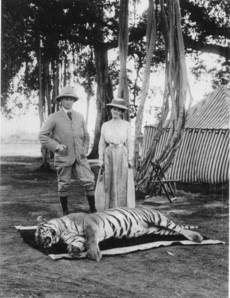| |
Hunting by
British in India
Tiger hunting by English
aristocrats in British India

A Shikar party in Mandalay,
Burma, soon after the conclusion of the Third Anglo-Burmese War in 1886
when Burma was annexed to British India.During the feudal and colonial
epoch on the Indian continent, hunting was a true 'regal sport' in the
numerous princely states, as many (Maha)rajas, Nawabs, as well as British
officers maintained a whole corps of shikaris, who were native professional
hunters. They would be headed by a master of the hunt, who might be styled
Mir-shikar. Often these were recruited from the normally low-ranking local
tribes because of their traditional knowledge of environment and hunting
techniques. Big game, such as Bengal tigers, might be hunted from the back
of an elephant.
Indian social norms are
generally antagonistic to hunting, while a few sects like the Bishnoi lay
special emphasis on the conservation of particular species like the antelope.
India's Wildlife Protection Act of 1972 bans the killing of all wild animals.
However, the Chief Wildlife Warden may, if he is satisfied that any wild
animal from a specified list has become dangerous to human life or is so
disabled or diseased as to be beyond recovery, permit any person to hunt
such animal. In such a case, the body of any wild animal killed or wounded
becomes government property
In the 19th century, southern
and central European sport hunters often pursued game only for a trophy,
usually the head or pelt of an animal, which was then displayed as a sign
of prowess. The rest of the animal was typically discarded. Some cultures,
however, disapprove of such waste. In Nordic countries, hunting for trophies
was -- and still is -- frowned upon. Hunting in North America in the 19th
century was done primarily as a way to supplement food supplies, although
it is now undertaken mainly for sport. The safari method of hunting was
a development of sport hunting that saw elaborate travel in Africa, India
and other places in pursuit of trophies. In modern times, trophy hunting
persists and is a significant industry in some areas.
|
|





